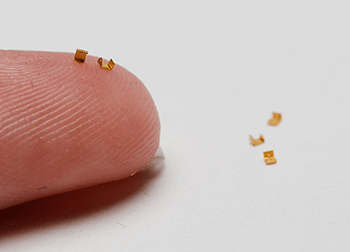Advancing Telemedicine Trends with Photochemical Etching
The COVID pandemic forced all of us into a new norm of social distancing, mask wearing, and remote communication. Some industries within manufacturing struggled to adapt their business strategies to maintain production. Others thrived with the new opportunities that the pandemic prompted.
As cases rapidly increased, the need to reduce travel and exposure became vital. This swift shift to digital life enabled new technologies of remote care in the healthcare industry that ensured continuity of critical services. In turn, the demand for smaller precision metal components increased to help produce and power these new technologies.

Upcoming Telemedicine Trends
According to Empeek Vice President, Yulia Shpachuck, “Whereas a year ago, the telemedicine market was worth $45.5 billion, in 2026, it is expected to reach a $175.7 billion threshold.”
Some of the trends the article reports responsible for that growth include:
- Artificial Intelligence and Augmented Reality
- Big Data and Stringent Data Security
- Electronic Health Record (EHS) Software Programs
- Internet of Medical Things (IoMT) and Medical Wearables
All these trends involve wireless transmission of communication and data through a wide range of complex precision components in different applications, including:
- Medical wearables and implantables
- Smart beds, inhalers, and EKG monitors
- Advanced data analysis platforms
- Machine learning algorithms
- Augmented reality navigation, education, and training systems
- Smart glasses for surgery and vein scanners
High quality is important especially when dealing with life-dependent technologies that require secure channels of transmission. Traditional manufacturing processes such as stamping, computer numerical control (CNC) machining, and laser cutting can negatively affect a metal’s integrity, which can compromise the performance of critical parts and cause catastrophic failures.
Photochemical machining (PCM) (also known as photochemical etching, chemical etching, or acid etching) is a subtractive metal fabrication alternative that falls within the rapid prototyping classification. It uses baths of temperature-regulated chemicals and a photoresist to define selective material removal to produce critical telemedicine parts.
Chemical Etching Benefits for Telemedicine Components
Photochemical etching answers the demand for low-cost, burr-free parts including hardened metals, without inducing stress. It produces intricate, close tolerance-patterns of complex geometries while eliminating the heat transfer issues of laser cutting and the physical impact force of mechanical techniques such as stamping.
The process is used for a variety of metals including pure metals and alloys such as titanium and molybdenum that are difficult to machine. With the use of digital tooling, chemical etching offers fast, flexible, and affordable prototyping that accommodates design re-iterations that are restricted with hard tooling options. Digital tooling also eliminates the cost and time associated with physical set-up for other traditional processes.
Photochemical etching typically takes less than a day, often less than an hour, to complete fully manufactured products. The process offers unlimited geometric customization with infinite repeatable accuracy without adding on extra expenses.
Chemical etching’s streamlined process helps OEMs save and improve lives by delivering their medical components and products to healthcare professions at faster rates and more efficient costs. As the latest trends in telemedicine continue to surface, photochemical etching is a great alternative process to keep up with the high demand.
